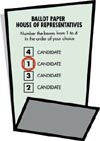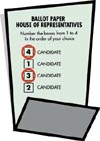Australian Electoral Commission


Voting is compulsory at federal elections for all Australian citizens over the age of 18 who are on the Commonwealth electoral roll at the close of rolls for the election.
Australians can cast their vote in several ways:
An elector making a postal, pre-poll, absent or provisional vote must complete a declaration giving their personal details. These details will be checked by the DRO during the counting of votes (the scrutiny).
| ordinary votes | absent votes | pre-poll, postal & provisional votes | |||
|---|---|---|---|---|---|
| 1998 | 82.10% | 1998 | 6.70% | 1998 | 11.20% |
| 1996 | 86.21% | 1996 | 5.82% | 1996 | 7.96% |
| 1993 | 87.39% | 1993 | 5.97% | 1993 | 6.65% |
The electoral systems used to elect members to the two houses of Australia's federal parliament are different.
Candidates for the Senate stand for election in a particular State or Territory. It is a Constitutional requirement that each State is equally represented in the Senate regardless of population. There are a total of 12 Senators for each State who are elected for a six year term. The two Territories are each represented in the Senate by two Senators who are elected for a maximum three year term equivalent to the duration of the House of Representatives.
Senators are elected by a proportional representation system. All the electors in a whole State or Territory are counted as the one electorate and vote in a number of Senators. To be elected, a candidate must win a proportion of the votes, also known as a quota.
There are a total of 76 positions in the Senate, and when a double dissolution is declared all 76 Senate positions are made vacant. At a half-Senate election, 40 Senate vacancies are up for election – six from each State and the four from the Territories. The 1998 federal election was a half-Senate election.
Candidates for the House of Representatives stand for election in a particular electoral Division, and are elected for a maximum three year term.
Members of the House of Representatives are elected using the preferential voting system, with the electors in each division electing one Member to represent them. To be elected, a candidate must win a majority of votes, that is more than half the formal votes cast for that division.
The total number of 148 positions in the House of Representatives are up for election at a federal election.

Following amendments to the Electoral Act, a House of Representatives vote marked 1,2,3,3,3,3..etc. is not counted as formal up to the point where duplication of numbers occurred. At the 1998 federal election, any vote marked in this way was rejected as informal.
On the Senate ballot paper a voter can either vote above the line or below the line, but not both.
Above the line: If a voter chooses to vote above the line, the number '1' is written in one of the boxes above the line. All other boxes on the paper are left blank. If a voter votes in the top section their preferences will be counted in the way chosen by the group or party voted for. This is called a group ticket vote and posters are displayed at all polling places showing how each party or group has decided to have their preferences distributed.
Only registered political parties or groups who have lodged a group voting ticket have a box above the line. At the 1998 federal election 94.9 percent of voters chose to vote above the line.
Below the line: If a voter chooses to vote below the line, all the boxes in the bottom section of the ballot paper must be numbered sequentially in the order of the voter's choice. The number '1' is written in the box of the voter's first choice candidate and the numbering is continued until there is a number in every box below the line, with no duplication of any number.
All the candidates running in the Senate election have a box below the line.
The House of Representatives votes are counted as follows:

The first preferences: First, all of the number '1' votes are counted for each candidate. If a candidate gets more than half the total formal first preference votes, that candidate will be elected.

The second preferences: If, however, no candidate has more than half of the votes, the candidate with the fewest votes is excluded. This candidate's votes are then transferred to the other candidates according to the second preferences shown by voters on their ballot papers.

Further preferences: If still no candidate has more than half the votes, the candidate who now has the fewest votes is excluded and the votes are transferred according to the next preference shown. This process continues until one candidate has more than half the total votes and is declared elected.
The Senate count is different from the House of Representatives and is more lengthy and complicated. A simplified summary of the main steps is as follows:
Working out the quota: To be elected to the Senate, a candidate needs to gain a certain proportion (or quota) of the formal votes. The quota is calculated by dividing the total number of formal ballot papers by one more than the number of Senators to be elected, and adding 1 to the result (ignoring any remainder).
Counting the first preference votes: This is done as for a House of Representatives election, with the papers sorted according to which candidate has received the number '1' preference on each ballot paper. Candidates who receive a quota, or more, of these first preference votes are elected immediately.
Transferring the surplus: Any surplus votes these elected candidates receive (i.e. votes in excess of the quota they needed) are transferred to the candidates who were the second choice of voters. However, they are transferred at a reduced value.
As a result of this process of transferring surplus votes, other candidates may be elected. If, however, all surplus votes from elected candidates are transferred and there are still some unfilled positions, another stage of the count is begun.
Exclusion of unsuccessful candidates: Starting with the candidate who has the least number of votes, unelected candidates are excluded from the count and their votes are passed on to the remaining candidates to whom the voters have given their preferences. The above process continues until all Senate positions are filled.
To be elected a candidate needs to get approximately 14% of all formal votes cast. Some candidates will get many more votes than this.
They are elected and their surplus votes are passed on to the candidates listed second on each ballot paper. But which ballot papers make up the quota and which are surplus?
In fact, all ballot papers are passed on according to the second preference shown, but because the first candidate has already 'used up' some of the value of these votes in being elected, the votes which flow on to the second preference condidates do not count as full votes.
(The exact value depends on how many votes the first candidate got: the more votes, the higher the value of the transferred votes.)
These 'transferred' votes are added to the second candidate's original (first preference) votes. If those candidates now have more than the quota of votes they need they are elected.
Their surplus votes are then transferred to the candidates listed as the next preference on the ballot papers. This process continues until there are no more candidates with enough votes to be elected.
If any of the 6 Senate places are not filled by this process, a different process is used to fill the remaining places.
The candidate with the smallest number of votes is excluded and preference from this candidate's ballot papers are transferred to the remaining unelected candidates.
This is done at the value at which the votes were received.
When the transfer of these preferences gives a candidate enough votes, that candidate is elected.
These processes of excluding the least popular candidate and transferring surpluses of elected candidates continues until 6 candidates have enough votes, i.e. have a quota, and are elected.
On the yellow referendum ballot paper, voters were asked to write whether they approved of the proposal for the Northern Territory to become a State. Voters who approved of the proposal, wrote the word 'yes' in the box on the ballot paper. Voters who did not approve of the proposal, wrote the word 'no' in the box.
The referendum ballot papers were counted to determine the number of electors who voted for the question and the number of electors who voted against the question. The result was determined by how the majority of voters had voted.
Ballot papers correctly marked according to the rules for voting are called formal votes and only formal votes contribute to determining the results of an election. Ballot papers that do not satisfy these rules are regarded as informal and after their total has been tallied they are excluded from any counting.
A House of Representatives ballot paper is informal if:
A Senate ballot paper is informal if:
A vote above the line will be informal if:
A vote below the line is informal if:
At each election, the AEC undertakes numerous activities to inform electors of the correct way to vote in the Senate and House of Representatives. These activities are aimed at minimising the number of voters who cast an informal vote and therefore waste their vote.
The following table provides a national comparison of the level of informal voting at federal elections held between 1987 and 1998.
| 1998 | 1996 | 1993 | 1990 | 1987 |
|---|---|---|---|---|
| 3.2% | 3.5% | 2.6% | 3.4% | 4.1% |
| 1998 | 1996 | 1993 | 1990 | 1987 |
|---|---|---|---|---|
| 3.8% | 3.2% | 3.0% | 3.2% | 4.9% |
A State and Territory comparison of the level of informal voting at federal elections held between 1987 and 1998 is presented in the table below:
| State/Territory | 1998 | 1996 | 1993 | 1990 | 1987 |
|---|---|---|---|---|---|
| NSW | 3.3 | 3.8 | 2.7 | 4.2 | 4.9 |
| VIC | 3.8 | 3.6 | 3.1 | 3.6 | 4.0 |
| QLD | 3.0 | 3.3 | 2.0 | 2.5 | 3.1 |
| WA | 2.7 | 3.5 | 2.1 | 2.9 | 3.3 |
| SA | 2.8 | 3.3 | 2.3 | 2.5 | 3.8 |
| TAS | 3.1 | 3.2 | 2.6 | 3.1 | 3.8 |
| ACT | 2.0 | 2.5 | 1.6 | 2.4 | 2.4 |
| NT | 2.0 | 2.8 | 2.8 | 2.8 | 3.7 |
| TOTAL | 3.2 | 3.5 | 2.6 | 3.4 | 4.1 |
| State/Territory | 1998 | 1996 | 1993 | 1990 | 1987 |
|---|---|---|---|---|---|
| NSW | 4.0 | 3.6 | 3.1 | 3.1 | 4.6 |
| VIC | 3.5 | 2.9 | 2.8 | 3.5 | 5.3 |
| QLD | 3.3 | 2.6 | 2.6 | 2.2 | 3.4 |
| WA | 4.2 | 3.2 | 2.5 | 3.7 | 6.6 |
| SA | 4.5 | 4.1 | 4.1 | 3.7 | 6.8 |
| TAS | 3.1 | 2.4 | 2.7 | 3.3 | 5.0 |
| ACT | 2.9 | 2.8 | 3.4 | 3.0 | 3.5 |
| NT | 4.2 | 3.4 | 3.1 | 3.4 | 5.8 |
| TOTAL | 3.8 | 3.2 | 3.0 | 3.2 | 4.9 |